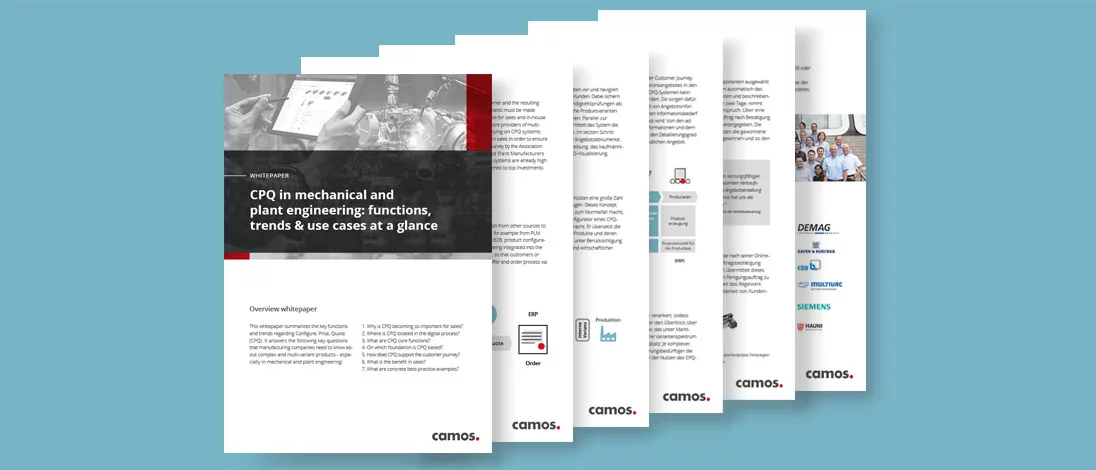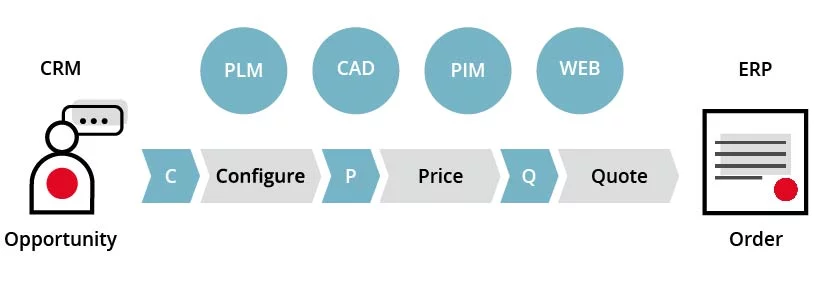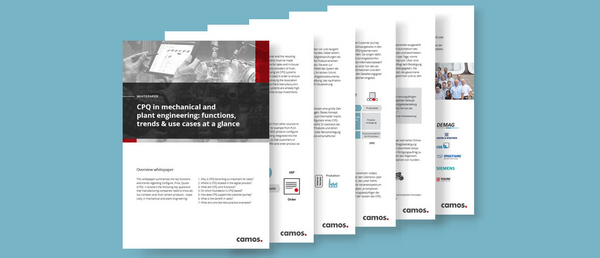Whitepaper - CPQ systems in mechanical and plant engineering: functions, trends & use cases at a glance
Overview whitepaper
This whitepaper summarizes the key functions and trends regarding Configure, Price, Quote (CPQ). It answers the following key questions that manufacturing companies need to know about complex and multi-variant products - especially in mechanical and plant engineering:
- Why is CPQ becoming so important for sales?
- Where is CPQ located in the digital process?
- What are the CPQ core functions?
- On which foundation is CPQ based?
- How does CPQ implement the Customer Journey?
- What is the benefit in sales?
- What are concrete examples of best practice?
Extract from the Whitepaper
1. Why is CPQ becoming so important for sales?
Mechanical and plant engineering is at the forefront when it comes to production batch sizes of one. According to the study „German Industry 4.0 Index 2019“ by Staufen AG, almost two thirds of the companies in this segment strive for this new level of individualisation. They have recognised that in future it will no longer be sufficient to rely solely on the success factors of quality, time and price. Digitisation offers companies new opportunities to customise their products in order to meet specific customer requirements. However, this means that the sales process has to be brought even closer to the customer and the resulting new high number of variants must be made economically manageable for sales and in-house production. More and more providers of multi-variant products are relying on CPQ systems (configure, price, quote) in sales in order to ensure future viability: A recent survey by the Association of German Machine and Plant Manufacturers (VDMA) shows that CPQ systems are already high up on the list when it comes to top investments in IT systems.
2. Where is CPQ located in the overall process?
A CPQ system can be seen as adigital bridge that brings the sales process closer to the customer and maps the customer requirements to production. It ensures that the growing demand for individualised products is met. From an IT perspective, this represents the link between the opportunity in the CRM system and the order in the ERP system. The CPQ system often imports the necessary information from other sources to create a convincing offer, for example from PLM, PIM or CAD systems. In B2B, product configuration is also increasingly being integrated into the company’s own website, so that customers or dealers can initiate the offer and order process via the Internet.
If you would like to read the full content of the whitepaper, please download it using the banner below.
We have collected the key questions from mechanical and plant engineers regarding CPQ solutions and answered them in the whitepaper:
- What are CPQ core functions?
- On which foundation is CPQ based?
- How does CPQ support the customer journey?
- What is the benefit in sales?
- What are concrete best-practice-examples?
Whitepaper CPQ systems in mechanical and plant engineering
This whitepaper summarizes the key functions and trends regarding Configure, Price, Quote (CPQ systems). It answers the following key questions that manufacturing companies need to know about complex and multi-variant products - especially in mechanical and plant engineering:
1. Why is CPQ becoming so important for sales?
2. Where is CPQ located in the digital process?
3. What are CPQ core functions?
4. On which foundation is CPQ based?
5. How does CPQ support the customer journey?
6. What is the benefit in sales?
7. What are concrete best-practice-examples?
All answers to these questions can be found in our white paper. This is particularly helpful if you want to find out about CPQ systems at an early stage and want to learn about the basics as well as the most important trends in the CPQ environment.


